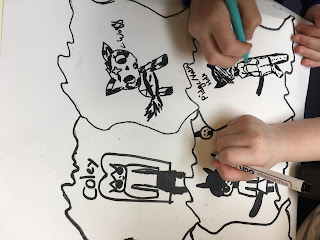Exploring pattern making - tessellations - Escher - 27th March, 2019
 |
| Curved tessellation |
As part of our learning about pattern design, today we looked tessellation in more detail, what it is - where we find it in everyday life and in nature and also looking at an artist from history who used tessellation to produce amazing works of art - Escher.
Jac gave a brief talk - how we can see tessellated pattern all around us, examples of man made and nature tessellation and told us about Escher, who he was and what inspired him. We found out that Escher was fascinated with tessellation - how shapes related to each other without any gaps.
 |
| Escher was inspired by Moorish tessellations he had seen in 1936 |
We covered many examples in the talk but in particular focused on this example, showing many creatures.
There are many creatures hiding but we managed to find most!
We looked at many examples and it was interesting to see the similarities from the fabric designs from Carlisle Archives from Ferguson's pattern books and also tweed design.
 |
| Ferguson's pattern book - Carlisle Archive |
 |
| Escher's designs |
 |
| Linton Tweed patterns |
As we had worked with geometric tessellation, our challenge today was to make a tessellated pattern with curves inspired by Escher.
Starting with a rectangular piece of card, we made this into a square by folding.
We carefully drew a wavy line along one side, cut this out and moved this to the other side, securing it with sellotape - we then did the same on the other edge - our challenge was to do this accurately.
This was very tricky and we had to concentrate hard.
 | ||
| Shapes - all different |
Then the magic started and our imagination! - what could we see within the shape? It was entirely up to us how we decorated our shapes - either repeating or drawing individual elements within each shape and we had amazing results!
There are many more excellent examples - it was a busy few hours and it would have been good to have had more time to completely finish - but some did and I will post these later. Well done everyone - it was a difficult activity but you all rocked it!
















Comments
Post a Comment